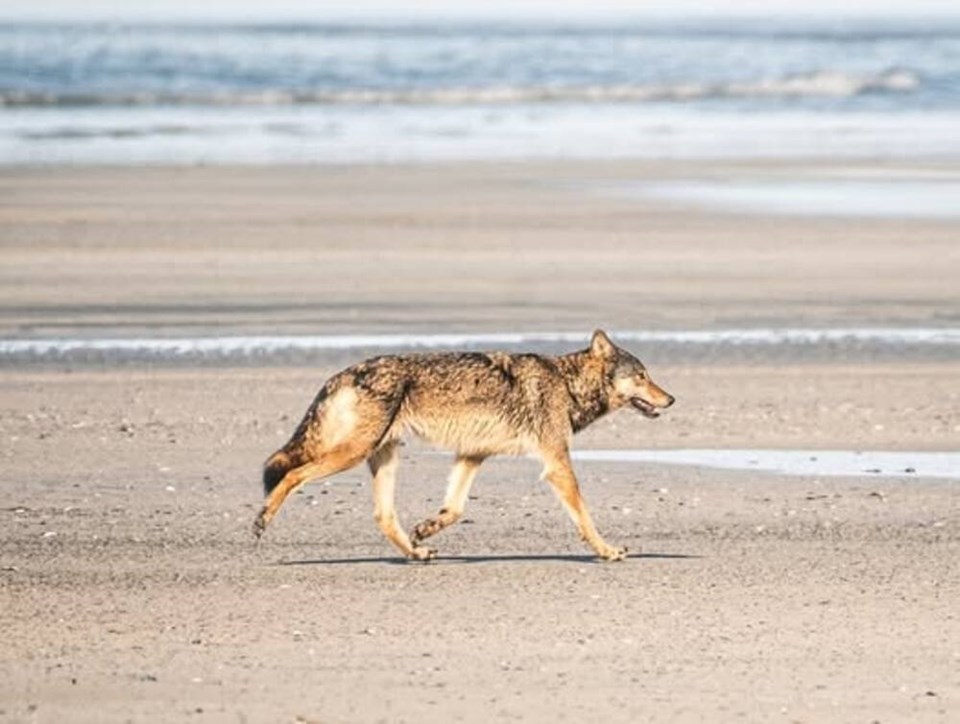A wildlife group is urging caution and calm after it received a report on Monday that a Metchosin resident and their dog had been chased by a pack of wolves.
Mollie Cameron, president of Sooke-based Wild Wise, said the incident in the Metchosin/East Sooke area was posted to social media in the early morning and could not be immediately verified. It was reported to the Conservation Officer Service and Canadian Force Base Esquimalt military police.
Cameron said the report is unusual because typically, wolves try to avoid human contact.
It’s unclear if the dog involved was leashed. Cameron said hikers in the area should ensure dogs are on a leash, so they don’t take flight, prompting a chase.
“It’s not uncommon for wolves to approach dogs that are on leash, but they want to elicit that flight response from those animals … they do that with all their prey, because that’s how they are successful hunters.”
Wolves are fast, often reaching speeds up to 60 km/h when chasing prey, which is difficult for any human or dog to outrun, said Cameron, adding wolves are not typically inclined to attack humans or pets unless they feel directly threatened.
The Conservation Officer Service said in a statement that it received reports of wolves in Metchosin on Monday and investigated the incident involving a dog.
It said wolves are territorial animals and “during the incident today they exhibited natural territorial behaviour.”
Wolves are common on Vancouver Island and can be encountered in wilderness and rural settings at any time, said the service, which recommends people take precautions including keeping dogs on a leash at all times and being aware of their surroundings.
Wolf sightings are becoming more common on the South Island, with recent reports of sightings at Royal Roads University and Esquimalt Lagoon as well as the prison at William Head.
Cameron said the coastal wolves on the Island don’t always travel in packs. “They will separate to monitor an area, look for prey like rabbits and deer, communicate by howling if there is something of interest to come back to … when you think of a wolf pack, don’t think that they will all be together all of the time.”
Also, just because we see a predator does not mean it’s stalking us, she added.
Over the years, wolves in the region have shown “minimal interest in conflict,” and typically have avoided human interaction, said Cameron. While sightings can be unsettling, they don’t necessarily indicate imminent danger, she said.
Wild Wise stresses the importance of not engaging with or attempting to photograph wolves.
“If we want wolves to remain wild, we must ensure that our actions do not interfere with their natural behaviors,” the group says, adding habituation to human presence can lead to dangerous interactions. “We must respect the wildlife by maintaining safe distances.”
Wild Wise advises anyone who encounters a wolf with a leashed dog to remain still and make loud noises to discourage any further approach. Back away slowly while maintaining eye contact when safe to do so.
Cameron said as apex predators, wolves play a crucial role in maintaining the health of the ecosystems they inhabit.
By controlling populations of ungulates like deer and elk, they help prevent overgrazing, preserve plant diversity and ensure the stability of the ecosystem, she said.
The Conservation Officer Service said it is continuing to monitor the situation and asked the public to report wolf interactions to the RAPP line at 1-877-952-7277.
For more information and safety tips, visit WildSafeBC.com.
dkloster@timescolonist



